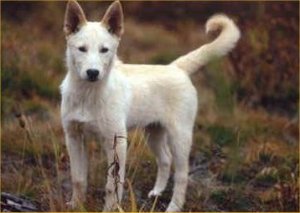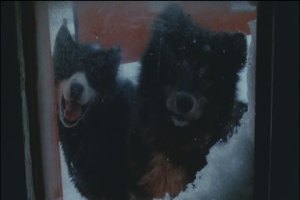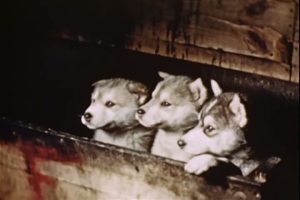Antarctic Echoes
 Antarctic Film Month draws to a close a week later than expected due to a bout of ill-health, with the appropriately named Antarctica, based on a true story and taking us back to the year 1957.
Antarctic Film Month draws to a close a week later than expected due to a bout of ill-health, with the appropriately named Antarctica, based on a true story and taking us back to the year 1957.
Antarctica
(1983) Written by Tatsuo Nogami, Susumu Saji , Toshirô Ishidô, & Koreyoshi Kurahara
Directed by Koreyoshi Kurahara
Showa, established in January 1957 on East Ongul Island, was and continues to be one of Japan’s most active Antarctic stations. After construction was completed, 11 men and 15 sled dogs remained on site and Showa began its long life as a polar scientific outpost. In February of the following year, the team left the base having completed their tenure, and the dogs were left behind with a small supply of food to keep them nourished until the relief crew arrived shortly afterward to take over their care. However, adverse weather conditions prevented the intended 2nd expedition team from making landfall, and the animals had to be abandoned. It would be a full year before another expedition team returned to Showa. Joining them was Professor Yasukazu Kitamura, responsible for the dogs in 1958 and whom had never forgiven himself for his decision to chain them together – a sentiment shared by the Japanese public of the day.

Early expeditions at Showa Station relied heavily on the use of sled dogs, leading to a deep bond between husky and handler.
The team would discover 7 dogs dead on the chain, with 6 having broken free and missing. Miraculously, brothers Taro and Jiro, who had been born and raised in Antarctica, had managed to survive. Kitamura suggested that they had subsisted on a diet of penguins, trapped fish, seal faeces, and seabirds. The dogs became national heroes and interest in the Sakhalin breed saw a major resurgence in Japan both in 1959 and again in 1983 with the release of Antarctica. Koreyoshi Kurahara’s epic dramatisation of these events combines both fact and fiction as it retells what is known as well as attempting to speculate on the fate of the huskies.
________________________________________________________________________________________________________
Connections
Showa Station also appears in Virus, aka Day Of Resurrection, where scientist Yoshizumi and his colleagues first learn of the infection’s decimation of Japan and beyond. The feature was reviewed recently as part of Antarctic Film Month.
_________________________________________________________________________________________________________
In the wrong pair of hands, it could easily be a cornball fest for animal lovers, but in practice, Antarctica manages to strike an acceptable balance between sentiment and historical drama, one in which the canine performers could be said to have equal screen presence with their human counterparts. To an extent, any film that makes use of Antarctica in its storytelling cannot help but be dramatic. The severe, jagged white landscape of the continent is the very essence of spectacle, and, as demonstrated in The Thing – even though the sci-fi/horror was filmed entirely in North America – a place of great hazard.
“In the wrong pair of hands, it could easily be a cornball fest for animal lovers, but in practice, Antarctica manages to strike an acceptable balance between sentiment and historical drama.”
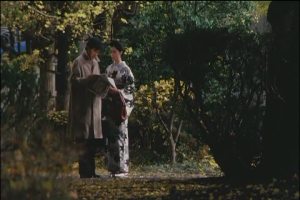
Forced to abandon the dogs to their fate, the expedition returns to a hostile reception, especially by the Japanese press.
All of this is encapsulated at the very beginning of Antarctica, from the montage of polar scenery accompanied by Vangelis’s dated but still powerful electronic score to the near-fatal expedition by Ushioda, Ochi and Ozaka, along with 15 sled dogs to remote inland post Botsnnuten. This sequence alone conveys the deep bond and interdependence between the dogs and their human masters, particularly the first two members of the team, responsible for the dogs’ wellbeing. Ushioda is the alter ego of Professor Kitamura in the film, and actor Ken Takakura expertly brings to life his Atlas-like sense of responsibility and later anguish at having chosen to chain the dogs together in the expectation that the 2nd expedition will ensure their care. With the expedition pilloried in the Japanese press for abandoning the dogs to their fate, both director Kurahara actors Takakura and Tsunehiko Watase as Ochi work hard to show that no-one was more haunted by that decision than the men themselves.
The film also suggests the wanderlust of the two dog lovers, the men finding themselves at a loss to reconnect to Japanese society upon their return. It is not only the dogs that they have left behind, but a major part of themselves and a sense of purpose as the pioneers of the new Antarctic base. Colorful and busy Hokkaido has carried on without them, its people only dimly aware of their experiences and unable to understand their feelings of disconnect. Indeed the only citizens who come close are the families who supplied the dogs, and bereft of their loved ones, have only recrimination to offer the polar scientists. The audience too feels a sense of alienation during the scenes in Hokkaido. We have also travelled to Antarctica and can’t quite reconcile the quiet university halls, bright traditional festivals, and rolling green fields of this world. This is made all the more powerful by the continual juxtaposition of these scenes with the ongoing fate of the dogs in the Antarctic: we cannot carry on without them because we alone know they are still there, and their fate has not yet played out.
With the humans gone from Showa, the dogs take centre-stage, and it is down to some serious animal training, special effects, and post-production that the Kurahara is able to sell his drama to the audience. A good measure of how successful this was is the fact that the director was criticised at the time for animal cruelty, gaining a rating of ‘Unacceptable’ by the American Human Association. Kurahara Productions would respond by stating that all death scenes or sequences placing animals in peril were carefully recreated in a studio under controlled conditions. Filming reportedly took place in the snow-covered climes of Northern Hokkaido, interspersed with second unit footage of Antarctica itself.
______________________________________________________________________________________________________________________________________________________________
Connections
The term Sakhalin derives from the Russian island of the same name, where the huskies were originally bred. North of Hokkaido, the long and slender landmass known in Japanese as ‘Karafuto’ has long been a point of contention for the two nations, only in recent history becoming fully Russian territory. Before this, its sovereignty regularly changed and it was once home to the Ainu, an indigenous population since relocated to Japan in the 20th Century. The dogs used in the expedition were bred in Hokkaido. Eight Below, Hollywood’s remake of Antarctica, uses Siberian huskies and Alaskan malamutes – a malamute also having been used in The Thing, reviewed last week.
Pictured left: A Sakhalin husky. Acknowledgements to www.dogfacts.org for the photo.
________________________________________________________________________________________________________________________________________________________________
“The audience too feels a sense of alienation during the scenes in Hokkaido. We have also travelled to Antarctica and can’t quite reconcile the quiet university halls, bright traditional festivals, and rolling green fields of this world.”
However it was done, the attempt at realism paid off, with the plight of the dogs still just as believable today as it appeared in 1983. Sequences that could now only be achieved through CGI are all the more solid and powerful knowing that they were practically realised. Kurahara seems also to be aware that such sequences can only be used sparingly, not only for dramatic reasons, but also because even in a canine-centric tale, human drama will always be more compelling.
This is further evident with the presence of a narrator over the scenes where the huskies are fending for themselves. It gives both the impression at times of a documentary, but also an uninvited dose of silliness, as the narrator attempts to explain what the dogs are feeling and their motivations in a particular scene. The viewer is well-aware of the situation and can easily discern the action from the screen. It would have been far more powerful to let the visuals and the soundtrack to tell the story than a patronising anthropomorphisation of the protagonists. Fortunately, this is not a major irritation and the visuals do indeed speak volumes.
There is a definite underlying theme of Japanese indomitability throughout the tale, perhaps unsurprising given the pioneering subject matter. An amusing scene between the rescued crew and the captain of the U.S icebreaker Burton Island assisting in their departure underscores the strong sense of nationalism that might have been more pervasive had Antarctica told the story of the Showa base itself. While those at home did not fully appreciate the difficulties of the mission, there was a great sense of national pride at the expedition itself. It had not been long since the Second World War and a rapidly rebuilding nation had in only 12 years joined the Antarctic program long dominated in the early 20th Century by public and private enterprise in the U.S. The sentiment of which only occasionally bubbles to the surface in Antarctica, serving as a powerful undercurrent to the story and a context to the ‘can-do’ spirit of the team, as opposed to a time-serving mentality one might be more likely to find in the South Pole today now that the novelty has worn off.
To the average viewer however, Antarctica is the poignant true story of life and death for man’s best friend in one of the harshest places on earth. I won’t claim to have shed tears during its 143 minutes, but having owned a dog or two in my life, I also cannot say I was unaffected by their predicament. There is a certain amount of guilt at confessing to an enjoyment of animal-based drama, largely in part due to Disney’s many years of cheapening the genre. The genuine article is a different beast altogether, and stands on higher ground with its honesty. Realistically-drawn, well-paced and visually-arresting, Antarctica remains an epic retelling of history and a compelling emotional tale for humans and canines alike decades after its original release. For the polar enthusiast, it returns us to the final days of an era when Antarctica was the last great frontier, before it was conquered by the inevitable mediocrity of familiarity and taxation.
*****
Further Reading
To see photos of the actual expedition at Showa Base and the dogs Taro and Jiro, visit this page. Scroll down until you see the photo section.
Click here to read the assessment of the American Human Association on Antarctica.
Visit this page to learn additional information, including the thoughts of Professor Kitamura.
*****
Next Time
Clips, or it didn’t happen: we return to where it all began and look at the ‘A’ series of World On Film – a chance to discover the films reviewed earlier all on one page. With pictures.
Deliverance
So far in this series, we’ve explored the triumph of science in the South Pole, looking at the ways in which Antarctica has been a frontier for advancing the human endeavour and a deeper understanding of our planet, both in fiction and genuine footage of a famous expedition. Time for a change of pace now. Antarctica isn’t a place of eternal wonder for all who have worked there, or, as with Virus: Day Of Resurrection last week, a land where the nations of the world put aside their differences for the greater good. Behind every polar expedition there were the grunts – the blue collar workers who carried out the actual hard work and fixed things when they broke down. Inevitably, their Antarctica would be far less glamourous.
Neither is Antarctica universally seen as simply a giant laboratory for altruistic science. Even during Byrd’s time, there were many who saw the South Pole as new land to conquer, its position more of strategic than scientific value. The U.S. Antarctic Expedition of 1939-1941 had as much to do with establishing an American presence there as it did exploration. Today, when the major nations have indeed become a permanent fixture at McMurdo and other base camps, many who work there simply see it as a job – one they are even taxed for – and certainly bound by government and commercial interests just as with anywhere else. Add to that the fact that Antarctica is a hostile environment far from most of the basic comforts, where holding onto one’s sanity is a very real concern, and where one is frequently trapped for months on end with people they don’t necessarily like, and the rose-coloured lens through which the Byrds of the world viewed Antarctica become mottled.
This rather sobering perspective forms the ethos for John Carpenter’s excellent remake of The Thing From Another World, itself an adaptation of the novella ‘Who Goes There?’ by John W. Campbell Jr, published in the August 1938 edition of America’s longest-running science fiction magazine, Astounding Stories. In terms of cinema, it is Carpenter’s version of the tale that has most famously – and most effectively – depicted the blue collar perspective on Antarctica, using the science fiction and horror of the novella as allegory for the difficulties they face there.
The Thing
(1982) Screenplay by Bill Lancaster Directed by John Carpenter
(You can find a trailer at the bottom of last week’s post)
“Somebody in this camp ain’t what he appears to be. Right now that may be one or two of us. By spring, it could be all of us.”

Far from being a wondrous, unexplored outpost of Earth, the Antarctica of ‘The Thing’ is a dangerous and claustrophobic wilderness.
In the story, a group of scientists stationed at an American Antarctic base encounter an alien life form able to change its shape into that of the host body it has infected. Suspicion turns to paranoia as it quickly becomes apparent that no-one is who he seems. As the fight for survival turns the base personnel against each other, the greater cost is soon realised: if the thing were ever to make contact with the outside world, all of humanity would be destroyed within three years.
One of the ways in which The Thing succeeds so well in its genre is the careful minimalism of Lancaster’s script and Carpenter’s direction. At no point do we ever truly learn, for example, of the alien’s origin, the reason it crashed to Earth, why it landed in Antarctica, whether or not it is sentient, or indeed its true objective in taking over other life forms. Even the title of the film makes this ambiguity plain and if anything, underscores not only the mystery, but the anti-intellectualism of the base personnel: it is simply a threat to be dealt with, its extra-terrestrial identity more of an irritation than of interest. Unsurprisingly, any survivors might argue that its lethality renders any such disinterest entirely justified.
“Behind every polar expedition there were the grunts – the blue collar workers who carried out the actual hard work and fixed things when they broke down. Inevitably, their Antarctica would be far less glamourous.”
Nor indeed do we learn a great deal about the characters themselves or the purpose of their presence in Antarctica. There seems little, if any, significant research being conducted there and what work does take place is of supreme indifference to the staff. They are simply filling out a contract and counting down the days to its completion. The base staff in turn appear merely to tolerate each other akin to Adamsian office workers, albeit office workers forced to see their colleagues round the clock and to the exclusion of all else. Conversation is stifled by familiarity, contempt, and lack of stimulus (until the drama begins) and entertainment takes the form of alcohol, months-old off-air television recordings, ping-pong, and a well-worn record collection.
Embodying this seemingly-pointless, isolated existence is the classic antihero and main character of R.J. MacReady, very convincingly played by a young and hirsute Kurt Russell. The perpetually Stetson-wearing, hard-bitten and cynical time-server is purposely constructed as a cowboy of the modern age, able to fit quite easily into the seedy saloon bar of some Tombstone-like frontier town of over a century ago. The anti-intellectualism inherent in MacReady and his fellows is expertly summed up in an early scene where his response to losing at computer chess is to pour the remains of his whisky into its circuitry.
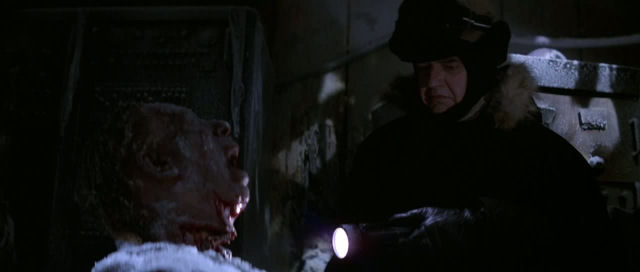
Explorations of the Norwegian base suggest the inhabitants may have had good reason to reduce the local dog population.
The cynicism and mistrust is further exemplified and exacerbated by other common elements of Antarctic life. Not only is technology seen to cause problems rather than solve them, but so too other nations – a far cry from the spirit of global fellowship seen in Virus. It is the Norwegians – often derided by others in Antarctica for their prowess in polar climates (and derogatively dubbed ‘Swedes’ by the main character) – who bring the alien to the U.S. base, having failed ironically to deal with it. Even in Virus, it is the Norwegians who are quicker to succumb than their multinational counterparts. Elsewhere, in another role-reversal, an Alaskan malamute, typically used as a sled dog, is the initial carrier of the alien creature.
The Antarctica of The Thing is not the land of adventure and opportunity. Its snow-covered jagged mountains are uninviting, its rolling plains bleak and lifeless, and its terrain offering nothing but mortal danger. It is far from the warmth of civilisation, will quickly kill anyone who strays from their electric-powered shelters with its sub-zero temperatures, and the ground beneath harbours monsters who bring swift, painful oblivion. The ‘thing’ is the ultimate Antarctic allegory for the long-term resident – the near-unbeatable agent of death who threatens to rob them of their humanity, not with merciful swiftness, but by rotting them slowly from within. The South Pole is still the giant laboratory it has always been for those looking at the other end of the microscope: at the furthest frontier of civilisation, humans are unwittingly being tested to see how they fare in extreme conditions. In reality, British Columbia doubles for the frozen continent, but is visually no less convincing to all but perhaps the skilled geologist. The brooding atmosphere is strongly accentuated by Ennio Morricone’s evocative score, different in style from Carpenter’s own compositions and unsurprisingly smoother and more accomplished, yet still fitting quite well into the era of the early Halloweens and The Fog.
The veteran horror director had by this point established his expertise in suspense-filled, well-paced tales of the macabre. The two films mentioned above were both classic examples of highly-effective base-under-siege drama, and in The Thing, Carpenter finally takes the term to its most literal conclusion. The cold, functional, and labyrinthine Antarctic base we see in the film is a perfect counterpoint to the bleak perpetual winter of nothingness outside. The disillusioned denizens inside provide only a candle-flame of human warmth, serving not even enlightened self-interest, but simply the powers of inertia. This disillusion is Carpenter’s contribution to the story, with the original novella produced during the positivist golden era of Byrd-mania. As is typically the case, the remake shows the rising cynicism of the public since the time of the original, no longer so easily caught up in nationalist fervour.
“The Antarctica of The Thing is not the land of adventure and opportunity. Its snow-covered jagged mountains are uninviting, its rolling plains bleak and lifeless, and its terrain offering nothing but mortal danger.”

As the mysterious infection begins to spread, the protagonists discover that it may not be home-grown in origin.
Carpenter and Russell had already collaborated on the director’s earlier apocalyptic outing, Escape From New York, with the young star by now fully aware of what was required of him. Other standouts in the cast include Wilford Brimley as Blair, the scientist who realises no-one present should be allowed to get out alive, Keith David as disbelieving aggressor Childs, and Donald Moffat as Garry, the self-admitting ineffectual leader of the base. A great deal of credit at this point should also go to both Jed, the Alaskan malamute, and his trainer, who between them do an excellent job of creating the dog’s alien nature. Jed, who would go on to play the title character in White Fang, though obviously unaware of the script, is one of the best trained dogs in the business, his body language convincing the viewer of his alter-ego’s menace with every step.
Pushing the envelope for early-80s practical effects is master of gore Rob Bottin, who in The Thing really gives contemporary innards wizard Lucio Fulci a run for his money. Bottin, whose make-up effects work includes The Howling, Twilight Zone: The Movie and Total Recall, lived on set for over a year during the making of The Thing, working round the clock to create visuals that were so gruesome for the period that they polarised film critics worldwide. While from a modern perspective, the clunky movement and obvious puppetry of the alien invaders is evident, so too is the sheer amount of detail in their construction. They are still far more ‘solid’ than any CGI equivalent, and still just as horrific in their design, helped by the well-matched screeching sound design. It could be argued effectively that a number of sequences exist simply to serve the visual effects extravaganza and a more cerebral interpretation of alien metamorphosis might have been employed. The Thing, however, is not intended to be The Midwich Cuckoos, and thanks to good pacing, does not fall into a long, drawn-out visual-effects love-fest at the cost of a story, which is more than can be said for Fulci’s The Beyond of the same period. It’s probably also fair to say that time and familiarity have dulled the senses with my reading of the film, and its efforts seem tame compared to say, Rob Zombie’s Halloween II.

Kurt Russell as R.J. MacReady, the anti-intellectual, time-serving helicopter pilot given yet another reason to get the hell out of Antarctica.
The somewhat forgiving nature for old cinema and a healthy suspension of disbelief also help in areas where The Thing does not accurately depict Antarctic life, allegorical or otherwise. Compelling though his performance is, Kurt Russell’s cool cowboy image is more 80s action hero than Antarctic expedition pilot, likewise Childs and Garry fit the typical formula of antagonist and weak authority figure, while radio operator and Jeff Lynne lookalike contest runner-up Windows clearly went to the Crispin Glover school of ‘We’re All Going To Die, Man!’ acting. The easy availability of firearms and flame-throwers to all personnel, along with the high population of open-standing fuel drums also tends to stretch credulity, even before the coming of the Antarctic Treaty. It’s easy to hold up the extra-terrestrial element as justification for action-genre fantasy, but every story should still operate within its own internal logic. Nonetheless, the abundant weaponry and especially flamethrowers are used to satisfying effect, the latter proving especially critical in helping contain the alien menace. Dramatic license is well-served, and the film reaches the type of satisfying ending one would reasonably expect of its horror shoot-em-up credentials, indeed concluding in Carpenter’s signature open-ended dystopian fashion.
And it seems that the story is not over. In 2011, viewers will discover just what happened at the Norwegian base prior to the events of The Thing in a new prequel due for release at the end of the year. Only time will tell if the exercise worthwhile. In the meantime, I encourage interested parties to rediscover the flawed, but entertaining ‘original’ in all its blu-ray glory. I had occasion recently to do just this and found it held up extremely well. It needn’t wash away all that optimistic Antarctic fervour, but perhaps the last word should go to Mr. Campbell himself in this extract from Who Goes There? as the alien spacecraft is destroyed in a mass of flame:
Somehow in the blinding inferno we could see great hunched things, black bulks glowing, even so. They shed even the furious incandescence of the magnesium for a time. Those must have been the engines, we knew. Secrets going in a blazing glory -secrets that might have given Man the planets. Mysterious things that could lift and hurl that ship -and had soaked in the force of the Earth’s magnetic field.
The human adventure continues.
Further Reading
- Keep up to date with the latest news on the U.S. Antarctic program and the people who make it possible with the Antarctic Sun.
- Serious Thing enthusiasts might like to read Robert Meakin’s in-depth analysis of the film here.
- Learn more about today’s Antarctic program and meet the people who actually work there, as well as discovering how they view the place.
*****
Next Time
Antarctica, February 1953: The first year of Japan’s new Showa Station has drawn to a successful close. The expedition team depart from the base to make way for the relief crew, leaving 15 huskies remaining behind with a small supply of food to keep them nourished during the changeover. However, adverse weather conditions prevent landfall and the second expedition never arrives. The dogs are abandoned to their fate, forced to survive alone in the harsh, polar landscape. Antarctic Film Month concludes with the epic true story of Antarctica, when World On Film returns. Click below to see the original trailer.
Song Of White
Having established our historical credentials last week, the polar journey continues with a dramatic left turn into thriller with the epic international co-production:
Virus, aka Day Of Resurrection
(1980) Co-written & Directed by Kinji Fukasaku
(You’ll find a trailer at the bottom of last week’s post)
“I wanted my name to be entered into the history books, but I wanted it to be for something meaningful, something lasting. What could I have done that would have made the slightest damn bit of difference… wha… what could I have done?”
Germ warfare plagues the earth when a military-created virus is accidentally released into the planet’s atmosphere, killing almost everyone worldwide. The only survivors are a group of scientists in Antarctica, where the virus lays dormant in extreme low temperatures. The international fragments of humanity must put aside their political differences and rebuild society; however the apocalypse may not yet be over.
Coming in at just over 156 minutes, Virus is a truly epic disaster movie from the days when practical and video effects were the only tools in the creative film-maker’s arsenal. At first, I found myself somewhat put off by the excessive theatricality of the production: there is enough ham in the acting to keep Smithfield Foods overstocked until the end of the Holocene epoch, while the unsubtle script, camera direction and film score give Virus a cartoon-like simplicity even Gerry Anderson would find over-the-top. Yet when I ‘clicked’ that this was in fact a pre-cgi precursor to a Roland Emmerich spectacular (fresh in my mind after having been recently silly enough to watch 2012), I found myself quickly shifting mental gears and relaxing into the cinematic pantomime that unfolded. The Emmerich comparison is no fleeting analogy either, as the future director of disaster and cheese must surely have worshipped at the altar of Kinji Fukasaku in his youth before inspiration told him to inflict a new ice age upon North America and play tectonic origami with the world’s continents all the while hand-cranking the cornball-o-matic up to ‘gruyere’. If anything, it’s only fair to give Fukasaku the credit for bringing the idea to the screen first – and I’ve always been a sucker for a fun disaster film.
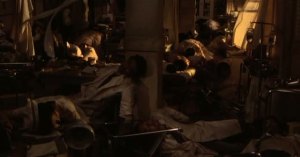
Crisis point: unable to contain the virus, doctors follow the fate of their patients as whole nations succumb to its deadly impact.
With disbelief now firmly suspended somewhere in limbo, I found myself glued to the screen as the world fell to its knees. Here was a tale of incredible human tragedy, where a terrified population succumbs to a disease from out of seeming nowhere. Hospitals are overrun, military law is imposed, and scientists work frantically in search of a cure. As the urban crowds thin and the bodies pile up in the streets, the ghostly silence of millions of souls sets a deathly pall over the landscape. A lone submarine crew surveys the damage from their watery quarantine, before setting a course for ‘home’, which we learn is Antarctica. And this is only the beginning of the tale. Fukasaku’s sharply-tuned sense of melodrama is so powerful that you can’t help but see past the cheese and be caught up in the horrible futility of mankind’s desolation and sense of despair at every tear-stained effort to hang onto existence, knowing they will come to dust.
The political commentary of Virus is similarly not intended to be subtle, with the engineered disease in question the product of one power bloc, designed to give it an edge over its rival. The finger of blame points squarely at the Soviets, yet ironically should be directed in the opposite direction. In the film’s Cold War allegory, we have met the enemy on home turf, and the broadly-drawn caricatures with their fingers on the button encapsulate the fears of 1980’s terrified speculation.
“[Director] Fukasaku’s sharply-tuned sense of melodrama is so powerful that you can’t help but see past the cheese and be caught up in the horrible futility of mankind’s desolation and sense of despair at every tear-stained effort to hang onto existence, knowing they will come to dust.”
The Japanese sensibilities of Virus also make it interesting viewing, since the film attempts to tell its story from multiple viewpoints and through chiefly American as well as Japanese protagonists. The broad caricatures of the U.S. government, for example, with its heroic president acting for the good of mankind, loyal senators, and egomaniacal army generals, not to mention scientists hushed up for the ‘common good’, all fit the typical Western disaster film profile perfectly. Yet both script and direction paint them with stereotypical brushes clearly not wielded by someone indigenous to the culture. They are too two-dimensional, if such a thing is possible – created by someone who sees only what is on the surface but doesn’t quite grasp the inner workings of their nature. Hollywood of course paints other cultures with precisely the same preconceptions and limitations in every single entry of the genre, but only through seeing your own culture pigeonholed by another does it become especially apparent. The Japanese sequences are no less Godzilla-like in their melodrama, meanwhile, with certain extreme performances so expertly lampooned on South Park, it’s hard not to emit a postmodern laugh.
Although the script’s more altruistic approach makes heroes of Americans as well as Japanese, only one man from the very beginning shines through the perpetual pantomime to become Virus’s true star, that of Masao Kusanakari as Doctor Shûzô Yoshizumi, the workaholic scientist who, while not necessarily holding all the answers to mankind’s salvation, is clearly the heart-throb hero of the piece. The international cast include a number of well-known figures, including George Kennedy, Robert Vaughan, Chuck Connors, and Olivia Hussey, but none can truly escape the limitations of their cardboard characters – the death scene of presidential loyalist Senator Barkley, as portrayed by Robert Vaughan, a case in point, or perhaps case closed. Nonetheless, the gravitas the veteran cast are able to convey within these limits adds weight to the drama – they at least are not playing things for laughs.
The film makes good use of extensive location filming, with the action taking place everywhere from Tokyo to Washington, stopping off at Macchu Picchu on the way to the Antarctic. Although Alaska and Canada frequently double for the South Pole, footage of the genuine article is intercut for added realism. In cinematic terms, Antarctica is frequently either the site of exploration and adventure of the battleground for man and extra-terrestrial. In a film powered by exaggeration, it’s certainly entirely plausible that a virus able to wipe out humanity would struggle to finish its work in colder climes, thus making the happenstance temporary residents of the frozen southern continent all who remain. That they would then be forced to put aside various national claims to slices of Antarctica is a very entertaining notion, with Fukasaku observing that even here, human nature would doom the remainder to extinction, not only due to power squabbles, but also the inevitable gender imbalance, all make for excellent post-war drama. It is very telling in these sequences who ultimately takes charge of the situation and what takes place as a result.
The ultimate difference between this very Japanese approach to storytelling and it’s Western disaster movie counterparts is the sheer bleakness of the piece. Over-the-top though it frequently is, Virus never succumbs to the nauseating Disneylike cheerfulness infesting the likes of Independence Day or The Day After Tomorrow. To put all of this on cultural tastes is possibly unfair, since Earthquake, hitting the silver screen six years earlier than Virus, manages to conclude without the vat of schmaltz its modern counterparts are drowned in. Nonetheless, it too cannot compare to the trademark Japanese fatalism seen everywhere from Evangelion to Battle Royale, wherein since humanity is taken literally to rock bottom in apocalyptic fury, even two-dimensional characters can develop as they are forced to deal with overwhelming odds. Virus is no exception: just when the viewer has reached the conclusion that the worst is over, it quickly becomes clear that the tumult is only just beginning and the rollercoaster car has just found an-almost vertical slope, its wheels already starting the terrifying descent.

The gender imbalance of the survivors mean multiple partners for the women, however even bleak necessity cannot stop matters of the heart.
This is the structure and raison d’etre of Virus, and the reason it rises up above its flaws. While its Cold War ethos is now a distant memory for those old enough to remember and an alien concept for a whole new generation in which all the major political chess pieces have shifted around the board, the sheer power of the film’s dramatic juggernaut is enough to make it arresting viewing decades later. It pulls at the same fundamental fears within us today and makes a mockery of the test-audience de-clawed demographic formulaic fluff that are its successors. Nonetheless, it is with a working knowledge of Armageddon, 2012 and their cousins that a modern audience will be able to approach Virus in any meaningful way. Hopefully the viewer will quickly find that the irony of that situation will quickly become irrelevant.
*****
Next Time
The sobering blue collar perspective of life in Antarctica is taken to extremes as a group of scientists stationed at an American Antarctic base encounter an alien life form able to change its shape into that of the host body it has infected. Suspicion turns to paranoia as it quickly becomes apparent that no-one is who he seems. As the fight for survival turns the base personnel against each other, the greater cost is soon realised: if the thing were ever to make contact with the outside world, all of humanity would be destroyed in a matter of weeks. John Carpenter’s memorable interpretation of The Thing next time, when World On Film returns. View the original trailer below:
Kinematic
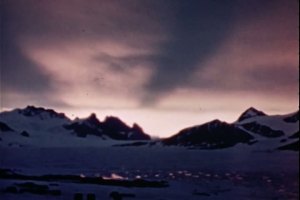
This week, we explore how and why Antarctica was captured in living colour for the very first time in the first chapter of Antarctic Film Month.
As the banner above subtly suggests, it’s Antarctic Month here at World On Film – not in fact corresponding to any particular month on the calendar (that would be too easy), but four weeks devoted to that large sweep of ice and land filling up the South Pole. The four films selected to represent it over those weeks will capture its many moods, but perhaps more importantly, the many ways in which we perceive Antarctica. It’s a place of distant beauty and adventure, but it’s also a place of danger and drudgery. Both fact and fiction will be used to explore the subject, and it all begins this week with the very first colour footage ever captured of Antarctica recorded during the United States Antarctic Expedition at the height of South Pole-mania.
Antarctic Echoes
Antarctica, the final frontier of Earth exploration, is an austere world of mystery and quiet menace. Once part of the massive supercontinent of Gondwanaland and covered in rainforest, its ancient past lies buried beneath impenetrable glaciers of ice, guarded by deadly ice-cold winds and temperatures hostile to human survival. It is today a glittering interglacial reminder of the powerful forces that shape our planet, and ready to claim the lives of any who dare to take its capricious nature too lightly.

Bound for the Antarctic, the crew make several pit stops along the way, including remote Pitcairn Island, where the Bounty mutineers settled centuries earlier. Here, a direct descendant of Fletcher Christian is caught on film.
This has not, however, stopped the bold and adventurous from setting a course for the South Pole with the unknown firmly in their sights and discovery fuelling their souls. The list of names associated with Antarctic exploration is long and embedded into the public consciousness, from Amunsden, Mawson and Scott, to Ross, Hillary and Fiennes. However, one name above all others defined human endeavour in the poles: Richard Evelyn Byrd. Not only did Byrd undertake no fewer than 11 expeditions to Antarctica, he was also responsible for galvanizing both government and public interest in the continent. He contributed significantly to and induced the enormous frenzy of scientific activity across the 20th Century that dramatically broke through the quiet, dismissive ignorance the world entertained about its most southerly neighbour.
“Antarctica, an austere world of mystery and quiet menace.”
At the height of the public interest in Antarctica Byrd had himself generated, the explorer, scientist and naval officer was a massive celebrity – almost impossible to believe when today’s incumbents of the term are the dubious breed of cheerfully ignorant, narcissistic attention-seekers whose trifling contributions to the human endeavour are championed and beamed across the globe with undeserving relentlessness by the media. Yet in his day, Byrd was every much as famous, his exploits excitedly recounted in newspapers and radio programs worldwide, his countenance visible on all manner of merchandising from stamps to signed photos. By 1935, he had overseen two highly-successful privately-funded expeditions to Antarctica, and both he and the public were hungry for more.
Eager to capitalise on this popular sentiment, the U.S. government of the day under the presidency of Franklin D. Roosevelt quickly began assessing the feasibility of a government-funded expedition to the region – the first in over a century. In 1939, the impressively-titled Executive Committee For The United States Antarctic Service was formed and Byrd, who had been preparing for his own return to the region since 1935, readily accepted the invitation to take charge of the new venture. Officially entitled, ‘The United States Antarctic Service Expedition’, to the public it was ‘Byrd Antarctic Expedition III’, with the Admiral overseeing the government objective of establishing a permanent seasonal base at ‘Little America’ and another south of the Cape of Good Hope.’ On November 1939, two vessels carrying 125 crewmen between them departed Boston for the Antarctic. Travelling with them was a young man about to make filmic history.
____________________________________________________________________________________________________________________________________________________________
Little America was in fact the name given to a series of bases on the Ross Ice Shelf near the Bay of Whales between 1929 and 1956. The breakup of the shelf has seen at least two Little Americas float away to see on icebergs. They were the site of the first-ever radio broadcasting stations in the Antarctic, which, during the expeditions, sent regular transmissions powerful enough to be picked up by household radio sets in the U.S, thereby significantly contributing to the ongoing public interest in the program.
_____________________________________________________________________________________________________________________________________________________________
Harrison Holt Richardson
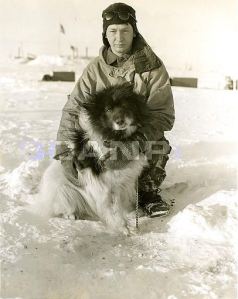 Responsible for capturing the expedition on celluloid was Byrd enthusiast and youngest member of the group, Harrison Holt Richardson. His interest in both Byrd and Antarctica began when, as a teenager, he attended a speech being given by the Admiral at Beaver College, Pennsylvania, where his father was a trustee. He would later write to Byrd hoping to persuade him to let Richardson join the crew of the U.S.S. Bear for the summer, a request which was later granted. Owned by Byrd, the Bear had been one of the principal ships used during his second expedition to the Antarctic, and Richardson the elder would subsequently convince Byrd to keep Richardson on for the third Antarctic expedition of 1939-41 in which the vessel was again utilised.
Responsible for capturing the expedition on celluloid was Byrd enthusiast and youngest member of the group, Harrison Holt Richardson. His interest in both Byrd and Antarctica began when, as a teenager, he attended a speech being given by the Admiral at Beaver College, Pennsylvania, where his father was a trustee. He would later write to Byrd hoping to persuade him to let Richardson join the crew of the U.S.S. Bear for the summer, a request which was later granted. Owned by Byrd, the Bear had been one of the principal ships used during his second expedition to the Antarctic, and Richardson the elder would subsequently convince Byrd to keep Richardson on for the third Antarctic expedition of 1939-41 in which the vessel was again utilised.
Richardson not only shot the first-ever colour footage of Antarctica, but also joined one of the scientific teams towards the end of the program. Over the winter of 1940-41, he would be a member of the biological team stationed there, working as a dog team driver and meteorological observer. Mt. Richardson in Marie Byrd Land, and discovered during his time there, would be named in his honour.
“Richardson not only shot the first-ever colour footage of Antarctica, but also joined one of the scientific teams towards the end of the program.”
In later life, Richardson would graduate from Geneva College and the University of Pittsburgh School of Medicine and serving in the U.S. navy as a medical officer during subsequent military expeditions to the North and South poles, helping to open the United States Air Force Base in Thule, Greenland, finally working as a radiologist for two hospitals back home. He would die at the age of 80 in 1999.
Richardson’s remarkable footage was produced using a 16mm film camera, which documents highlights of the 3-year expedition, from the crews’ departure in Boston to the closure of Little America in 1941. The silent footage would subsequently go out under the film title Antarctica, unsurprisingly credited to the United States Antarctic Expedition Service, with the occasional caption card to provide some kind of narrative.
Captured On Film

Face to face: penguins prove the most captivating of the local fauna, though whether scientists would get this close today is a different matter.
Whether or not Richardson was given much direction as to what he should document, the young cameraman/cinematographer does an excellent job under the circumstances, making sure to capture every aspect of the expedition, from the multifaceted scientific programs conducted to the equipment used in their implementation and the people behind it all who would go on to make history. He is also adept at capturing some of the breathtaking scenery and the mood of those around him. Probably the happiest surprise for me at least in viewing Antarctica is the fact that Richardson starts filming in Boston harbour at the very beginning of the journey, with impressive equipment like the Snow Cruiser, the overambitious and ultimately problematic all-terrain diesel car designed for ground-based mobility at the other end, excitedly paraded along the wharf prior to loading. An enthusiastic crowd is assembled, excited to be present at the momentous new chapter of scientific history, while crewmembers aboard the USMS North Star, the first ship to depart, cavort about on deck in pirate costumes, clearly lapping up every minute of their fame.
Along the way to icier climes, the crew would check in at destinations no less interesting, such as Pitcairn Island and Rapa Iti, with Richardson’s camera work ensuring the stopovers are saved for posterity. Pitcairn Island is a rich subject unto itself, being the very remote southern paradise the mutineers of the H.M.S Bounty would choose to make their home centuries earlier, with the North Star encountering their latter-day descendants as they trade for much-needed items during the 48-hour stopover. To the West, Rapa Iti, tropical outpost of French Polynesia and sinking volcanic remnant of a younger Earth, offered further trade and shore leave for the crew. Not to be confused with Rapa Nui (Easter Island), ‘Little’ Rapa bears the legacy of similar feats of stonemasonry, this time in the form of hill forts rather than giant statues. Richardson however, appears to be less concerned with history than the bare-chested Polynesian natives – his interest purely in anthropology never in doubt for a moment.
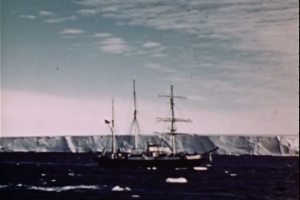
The North Star, one of the principal ships of the expedition and previously owned by famed polar adventurer, Richard Evelyn Byrd. Although a government endeavour, the public viewed this very much as his latest expedition.
Choosing not to document the most crucial stopover of all in Dunedin, New Zealand, which would act as a major supply stop for the Bear and the North Star over the course of the expedition, the filming resumes once more as the first icebergs hove into view – promising monuments of the main act and harbingers of the many pitfalls waiting for anyone daring to venture beyond.
“The first icebergs hove into view – promising monuments of the main act and harbingers of the many pitfalls waiting for anyone daring to venture beyond.”
Then begins the expedition proper, with Richardson producing many recorded highlights throughout. The Snow Cruiser quickly demonstrates its design flaws from the moment it leaves the ship in much the same way that elephants and rope bridges don’t mix. Some of the scientists develop a deep fascination for the local penguin population, engaging in an intimacy that today’s naturalists would frown upon. Meanwhile, the spectre of death looms over the team, with crevasses hiding their true depths and threatening to swallow up the unsuspecting newcomer for all time. Away from all this, the natives show how perfectly they have evolved to suit the natural environment, with seals surfing joyfully across the powdery surface of the land towards the food-rich depths of the icy water, while rubbery penguins bounce across the achromatic landscape very much at home in this frozen world.
The expedition would nonetheless become more adept at survival in the Antarctic than most, and snapshots of their efforts give tantalising glimpses into their mission. Every conceivable scientific study was conducted over the three-year period, from biological to meteorological. Two bases were maintained, 3,540km apart from each other by sea and 2,575km apart by air. With this, successive teams made up of scientists and the U.S. military were able to fill in the gaps between lands explored by previous expeditions. The Bear would be regularly deployed along the coastline, often hampered by sea ice. Seaplanes would venture inland as well as helping to determine whether sections of coast were island or peninsula. Sledging parties would all for ground-based research, often away for weeks at a time and subject to the harsh Antarctic weather. Together, their efforts would result in the mapping of some 1,127km of coastline, as well as shed light on current glaciations and fully map ranges such as the Queen Maud Mountains, which Byrd had discovered several years earlier.
The daily work of the expedition, from the maintaining of the bases, to the construction and maintenance of equipment and even the feeding of the huskies (seals being their primary diet) can also be seen. Camaraderie and downtime show a cheerful atmosphere, and there can be no doubt that such an experience would create very strong bonds among the crew.
The camera lens also captures the otherworldly, yet very Earth-like quality of Antarctica itself. Huge, jagged pyramids of rock rise into the sky, forming mountain ranges that fade off into the horizon where few have dared to tread. Hauntingly-beautiful coastlines radiate the sun’s rays while offering none of its warmth. Terrain, forged and crumpled by glaciers that melted before the time of man, is beaten relentlessly by icy, power-filled winds. Blocks of ice as large as Hyde Park collapse into the sea. Icebergs, some as flat as table-tops, others emulating the pointed mountains they have left behind, float almost imperceptibly forward – some returning to the continental shelf, others destined to drift out of sight forever.
By 1941, global upheaval had reached fever pitch, and the base camps would be abandoned, much of their personnel redeployed to join the conflict. Antarctica’s airwaves fell silent and the dreams of establishing a permanent presence in the region were forgotten in the chaos of the Second World War. The Antarctic program would eventually continue, however, and thanks to Harrison Holt Richardson, the golden days of polar exploration are there in full colour for future generations to enjoy.
You too can enjoy it for yourself by clicking on the video below. To compensate for the lack of audio, I watched it accompanied by – what else – Vangelis’s soundtrack to the 1983 film Antarctica.
*****
Further Reading
Unsurprisingly, there is no shortage of resources on the expedition. Those searching online in particular will find a plethora of resources, including this site, which gives a good overview of 200 years of Antarctic exploration, as well as chronicle the life of Admiral Byrd himself.
In contrast, little information exists on Harrison Holt Richardson, and what I did find was largely sourced from his New York Times obituary.
Next Time
Germ warfare plagues the earth when a military-created virus is accidentally released into the planet’s atmosphere, killing almost everyone worldwide. The only survivors are a group of scientists in Antarctica, where the virus lays dormant in extreme low temperatures. The international fragments of humanity must put aside their political differences and rebuild society; however the apocalypse may not yet be over. The epic Japanese thriller Virus, aka Day Of Resurrection next time when World On Film returns. Click below to view the original Japanese trailer:


